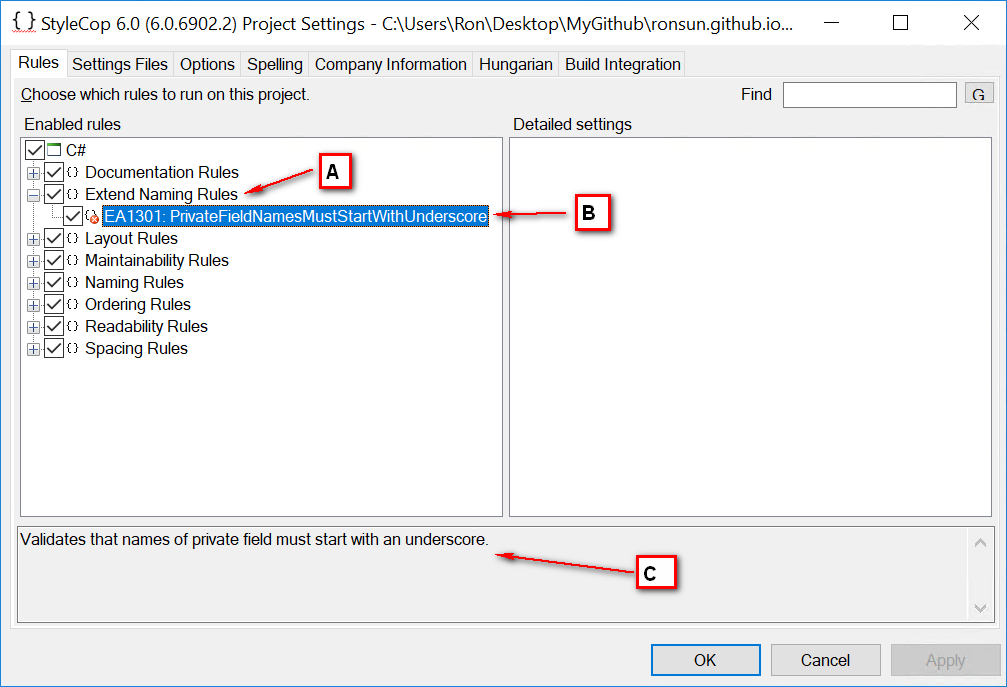很多 .NET 開發人員對於 StyleCop 應該是不陌生, 它能有效地協助我們讓程式碼的風格保持一致, 預設的規則其實已經足夠了, 但有些團隊可能有自已的特殊編碼規範, 這些編碼規範甚至是跟預設的規則是衝突的, 這時候就需要自己寫規則來套用.
這篇主要是針對自訂規則可能會面臨的問題所記錄的, 尤其是要怎麼測試這些規則沒寫錯, 所以對於一些 google 就可以很容易找到的部分只會簡單帶過, 另外由於 StyleCop 也滿大的, 所以有些太細的設定或是內部運作這篇也不打算深入探索, 等之後有需要或是有興趣再根據各個主題或面向來專題探討.
安裝 StyleCop
安裝 StyleCop 的方式隨便問一下 google 大師就有很多教學了, 可以從 NuGet 找到 StyleCop.Analyzers 裝在各自專案上也可以從 Tools > Extensions and Updates 找到 StyleCop 裝到本機電腦上, 我會比較推薦從 Extensions and Updates 裡面裝, 因為只有需要裝一個 StyleCop 擴充元件就能夠套用到所有的專案上, 各專案只需要編輯各自的設定檔就可以了, 非常方便.
安裝後的目錄在 C:\Users\{username}\AppData\Local\Microsoft\VisualStudio\{version}\Extensions\{key} 中, 其中 username 是本機使用者登入的名稱, version 是 visual studio 的版本號, key 是隨機產生的, 如果安裝很多擴充元件的話要一個個點進去找一下才知道哪個是 StyleCop 的.
使用 StyleCop
都是 visual studio 上面點一點就好的, 教學資源也極多, 基本的使用就不多說了.
編輯 StyleCop 設定檔
編輯 StyleCop 設定檔的方式一般只要從 visual studio 上開啟圖形介面就可以編輯專案要用的設定了, 另外一種方式是使用 StyleCop 的安裝目錄 (如上一段所說的位置) 中的 StyleCop.SettingsEditor.exe 來編輯, 雙擊設定檔或是用命令提示字元下 StyleCop.SettingsEditor.exe Settings.StyleCop 指令就可以, 其中 Settings.StyleCop 是設定檔的路徑, 這個工具是用來編輯設定檔的, 所以不能建立一個新的設定檔, 要編輯的設定檔也必須是符合規定的格式, 不然讀取會錯誤.
比起在 visual studio 中開啟圖形介面編輯設定檔, 用工具編輯雖然看起來不實用, 但是在需要製作很多份不同設定檔的時候卻很適合 (例如要測試自訂規則的驗證結果時), 這部分後面會說.
如果覺得 StyleCop.SettingsEditor.exe 不能建立一個新的設定檔很不方便, 可以把原始碼 fork 出來, 自己改造成適用的小工具.
自訂規則
自訂規則的部分步驟還不少, 而且很多情況下做錯也不會跳錯誤訊息, 所以花了不少時間在 try and error 上, 我在 GitHub 上面有放了一個簡單的自訂規則的專案 - ExtendedStyleCopRules, 這一段的說明會以這個專案的內容當作範例.
依賴組件
有幾個需要依賴的組件
- StyleCop
- StyleCop.CSharp
依賴的組件可以選擇從 NuGet 裝, 也可以直接依賴到前面從 Extensions and Updates 裝好的 StyleCop 的安裝目錄下, 這邊是建議直接從 NuGet 裝, 因為 StyleCop 擴充元件的安裝資料夾名稱是隨機的, 換台電腦就找不到引用了, 很難管理.
另外這邊要注意一下, 依賴的組件如果是從 NuGet 抓的, 必須跟從 Extensions and Updates 上安裝的 StyleCop 版號一致, 例如: 如果我從 Extensions 上安裝 StyleCop 6.0, 開發自訂規則時依賴的是從 NuGet 上面安裝的 StyleCop, 這樣編譯出來的組件無法讓 StyleCop 正確載入.
規則設定檔
要讓 StyleCop 能夠將自定規則的相關設定放在設定頁面, 需要一個 xml 格式的設定檔, 並將這個檔案屬性設定為編譯成 Embedded Resource, 這邊以 ExtendedNamingRules.xml 以及一張設定截圖為例.
1 | <?xml version="1.0" encoding="utf-8" ?> |

xmlns="....": 非必要, 只是沒有自動提示 (IntelliSense) 要寫這些 XML 太難過了, 所以自己刻了一個 SourceAnalyzer.xsd 來引用.Name="Extend Naming Rules": 這個 SourceAnalyzer 的名字, 會顯示在圖中 A 點.<Description>Extended naming rules.</Description>: 這個 SourceAnalyzer 的描述, 點擊圖中 A 點時會顯示在圖中 C 點的位置.Name="PrivateFieldNamesMustStartWithUnderscore": 規則名字, 顯示在圖中 B 點, 必須是大寫字母開頭.CheckId="EA1301": 規則代號, 圖中 B 點, 也是違反規則時顯示在結果視窗中的代號, 必須是兩個大寫字母加四個數字.<Context>.....</Context>: 提示訊息, 違反規則時顯示在結果視窗中的訊息之一.<Description>Validates that names...</Description>: 規則描述, 點擊圖中 B 點時會顯示在圖中 C 點的位置.
其實這個 XML 可以很複雜, 這個範例只是最簡單的情境, StyleCop 的官方文件區也有一些簡易說明, 不過如果要完整的內容的話, 可能需要去整合 StyleCop 所有規則的設定檔, 或是直接爬程式碼分析 XML 的完整結構了.
程式碼
先上程式碼再來慢慢說明.1
2
3
4
5
6
7
8
9
10
11
12
13
14
15
16
17
18
19
20
21
22
23
24
25
26
27
28
29
30
31[]
public class ExtendedNamingRules : SourceAnalyzer
{
public override void AnalyzeDocument(CodeDocument document)
{
CsDocument csdocument = (CsDocument)document;
if (csdocument.RootElement != null && !csdocument.RootElement.Generated)
{
csdocument.WalkDocument(new CodeWalkerElementVisitor<object>(VisitElement));
}
}
private bool VisitElement(CsElement element, CsElement parentElement, object context)
{
// not target element
if (element.Generated ||
element.ElementType != ElementType.Field ||
element.AccessModifier != AccessModifierType.Private)
{
return true;
}
if (!element.Declaration.Name.StartsWith("_"))
{
AddViolation(element, Rules.PrivateFieldNamesMustStartWithUnderscore);
}
return true;
}
}
StyleCop 是把原始碼拆解成 Element, Statement 和 Expression, 然後走訪所有節點並根據委派方法決定驗證邏輯與行為.
這個類別需要使用 SourceAnalyzer 這個 Attribute 並繼承 SourceAnalyzer 後覆寫相關的分析方法 void AnalyzeDocument(CodeDocument document), 接著 WalkDocument(...) 這邊會開始走訪所有程式碼, 然後根據委派方法 VisitElement(...) 來判定違規與否以及添加違規訊息等, 另外 WalkDocument 方法還有其他多載能另外多帶兩個參數, 是用來驗證 Statement 和 Expression 的委派方法.
後來在 Element, Statement 和 Expression 外又多了一個 QueryClause, 看起來是針對 LINQ 語句做的, 例如
var q = from prod in db.Prodcut where prod.Category == "shoes", WalkDocument 方法有一個多載提供委派方法 queryClauseCallback, 用途和其他委派應該差不多.
在刻這些規則時發現, 對於複雜一點的規則很難下手, 其中一個原因是不知道 StyleCop 是把程式碼拆解成什麼樣子, 驗證時需要用的拆解後的程式碼片段也不知道從哪裡得到, 這時候一個方法是去看 StyleCop 的原始碼, 或是偷懶一點, 利用測試在 debug 模式下看 CsDocument 的完整結構與相對應的值, 測試的方式後面會提到.
測試自訂規則
這個測試的目的是測試自訂規則是不是能正確驗證程式碼, 比較像整合測試.
這邊的範例需要依賴一些組件, 從 NuGet 安裝即可
- StyleCop (必要)
- NUnit (測試框架)
- FluentAssertions (Assert 用的套件)
下面是主要的程式碼片段與說明1
2
3
4
5
6
7
8
9
10
11
12
13
14
15
16
17
18
19
20
21
22
23
24
25
26
27
28
29
30
31
32
33
34
35
36
37
38
39
40
41
42
43
44
45
46
47
48
49
50
51
52
53
54
55
56
57
58
59
60
61
62
63
64
65
66
67
68
69
70
71
72
73[]
public class ExtendedStyleCopRulesTests
{
[]
public void RuleTest(string checkId, StyleCopViolations expectedValidationResult)
{
// arrange
Directory.CreateDirectory(Locations.ValidationResultDirectory);
string validationResultPath = Path.Combine(Locations.ValidationResultDirectory, $"{checkId}.xml");
string ruleSettingPath = Path.Combine(Locations.TestDataDirectory, checkId, $"{checkId}.StyleCop");
string codePath = Path.Combine(Locations.TestDataDirectory, checkId, $"{checkId}.cs");
CodeProject project = new CodeProject(
checkId.GetHashCode(),
Locations.BaseDirectory,
new Configuration(null),
0);
StyleCopConsole console = new StyleCopConsole(
ruleSettingPath,
false,
validationResultPath,
Locations.AddInDirectory,
false,
Locations.BaseDirectory);
console.Core.Environment.AddSourceCode(project, codePath, null);
// act
console.Start(new CodeProject[] { project }, true);
StyleCopViolations actualValidationResult;
using (Stream s = new FileStream(validationResultPath, FileMode.Open))
{
var serializer = new XmlSerializer(typeof(StyleCopViolations));
actualValidationResult = (StyleCopViolations)serializer.Deserialize(s);
}
// assert
bool testDataExist = File.Exists(ruleSettingPath) && File.Exists(codePath);
testDataExist.Should().BeTrue();
actualValidationResult.ViolationItems.Should().BeEquivalentTo(expectedValidationResult.ViolationItems);
}
private static List<object[]> TestCase_RuleTest()
{
var expectedValidationResult = new StyleCopViolations() { };
return new List<object[]>()
{
EA1301TestResource()
};
}
private static object[] EA1301TestResource()
{
string checkId = "EA1301";
var expectedValidationResult = new StyleCopViolations()
{
ViolationItems = new List<StyleCopViolations.Violation>()
{
new StyleCopViolations.Violation()
{
LineNumber = "7",
RuleNamespace = "ExtendedStyleCopRules.NamingRules.ExtendedNamingRules",
Rule = Rules.PrivateFieldNamesMustStartWithUnderscore.ToString(),
RuleId = checkId
}
}
};
return new object[] { checkId, expectedValidationResult };
}
}
測試的部分是參考 StyleCope 原始碼中的測試專案, 其實主要功能 StyleCop 都有提供, 也就是上面程式碼中的 CodeProject 和 StyleCopConsole, 這一句 console.Start(new CodeProject[] { project }, true) 執行後會根據指定的程式碼檔案 (codePath) 以及套用的 StyleCop 規則 (ruleSettingPath) 健行驗證, 並將檢查結果輸出成 XML 存檔到指定位置 (validationResultPath), 接著我們再讀取檢查結果驗證是否符合預期.
完整測試程式碼可以看 GitHub
其實 StyleCop 的測試專案是連預期驗證結果都寫成 XML 了, 比這個複雜多了, 不過以自己的小專案來說, 還是先簡單就好, 等規則多到像 StyleCop 那樣再說 (應該不可能).
套用規則
編譯好, 把 dll 放到 StyleCop 擴充元件的安裝目錄下, 然後重開 visual studio 就可以了.
結論
StyleCop 教學資源多集中在說明怎麼使用, 自訂規則的文章也不少, 但有提到測試的很少了, 所以乾脆直接跳進去看 StyleCop 內建的規則和測試是怎麼寫的, 順便整理了一下相關的 XML 規格刻個 XSD 來輔助使用, 而且測試的部分能協助我們在偵錯模式下去看被 StyleCop 拆解後的程式碼, 也更容易知道怎麼判斷程式碼是否違規.
以往沒看套件原始碼的習慣, 雖然剛開始看覺得很有障礙, 不過當作觀摩練習也是不錯.
參考
Instant Stylecop Code Analysis How-to (書)
StyleCop
How to Implement a Custom StyleCop Rule
C# Code Reviews using StyleCop – Detailed Article
Part I: Creating Custom Rules for Microsoft Source Analyzer
Part II: Creating Custom Rules for Microsoft Source Analyzer
Part III: Creating Custom Rules for Microsoft Source Analyzer
有些資料比較久了, 小細節和現在不一定相同, 不過說明很詳細, 對於了解 StyleCop 是很有幫助的